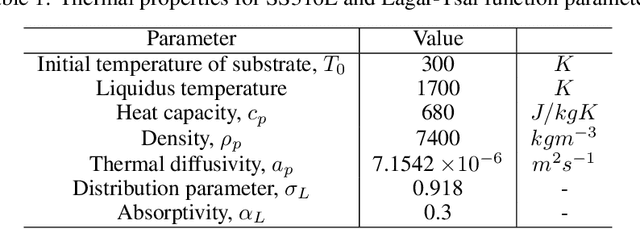Nandana Menon
Multi-fidelity surrogate with heterogeneous input spaces for modeling melt pools in laser-directed energy deposition
Mar 19, 2024



Abstract:Multi-fidelity (MF) modeling is a powerful statistical approach that can intelligently blend data from varied fidelity sources. This approach finds a compelling application in predicting melt pool geometry for laser-directed energy deposition (L-DED). One major challenge in using MF surrogates to merge a hierarchy of melt pool models is the variability in input spaces. To address this challenge, this paper introduces a novel approach for constructing an MF surrogate for predicting melt pool geometry by integrating models of varying complexity, that operate on heterogeneous input spaces. The first thermal model incorporates five input parameters i.e., laser power, scan velocity, powder flow rate, carrier gas flow rate, and nozzle height. In contrast, the second thermal model can only handle laser power and scan velocity. A mapping is established between the heterogeneous input spaces so that the five-dimensional space can be morphed into a pseudo two-dimensional space. Predictions are then blended using a Gaussian process-based co-kriging method. The resulting heterogeneous multi-fidelity Gaussian process (Het-MFGP) surrogate not only improves predictive accuracy but also offers computational efficiency by reducing evaluations required from the high-dimensional, high-fidelity thermal model. The results underscore the benefits of employing Het-MFGP for modeling melt pool behavior in L-DED. The framework successfully demonstrates how to leverage multimodal data and handle scenarios where certain input parameters may be difficult to model or measure.
A Reinforcement Learning Approach for Process Parameter Optimization in Additive Manufacturing
Nov 17, 2022



Abstract:Process optimization for metal additive manufacturing (AM) is crucial to ensure repeatability, control microstructure, and minimize defects. Despite efforts to address this via the traditional design of experiments and statistical process mapping, there is limited insight on an on-the-fly optimization framework that can be integrated into a metal AM system. Additionally, most of these methods, being data-intensive, cannot be supported by a metal AM alloy or system due to budget restrictions. To tackle this issue, the article introduces a Reinforcement Learning (RL) methodology transformed into an optimization problem in the realm of metal AM. An off-policy RL framework based on Q-learning is proposed to find optimal laser power ($P$) - scan velocity ($v$) combinations with the objective of maintaining steady-state melt pool depth. For this, an experimentally validated Eagar-Tsai formulation is used to emulate the Laser-Directed Energy Deposition environment, where the laser operates as the agent across the $P-v$ space such that it maximizes rewards for a melt pool depth closer to the optimum. The culmination of the training process yields a Q-table where the state ($P,v$) with the highest Q-value corresponds to the optimized process parameter. The resultant melt pool depths and the mapping of Q-values to the $P-v$ space show congruence with experimental observations. The framework, therefore, provides a model-free approach to learning without any prior.
 Add to Chrome
Add to Chrome Add to Firefox
Add to Firefox Add to Edge
Add to Edge